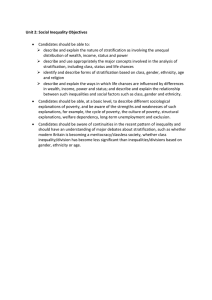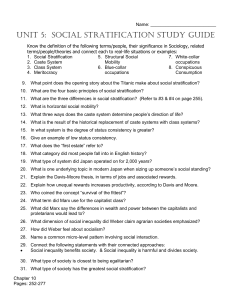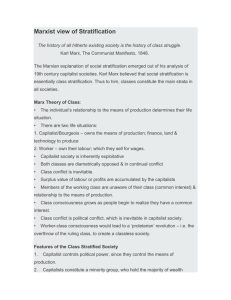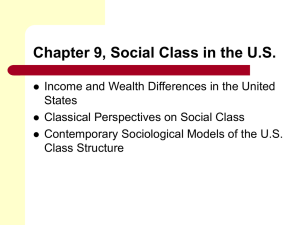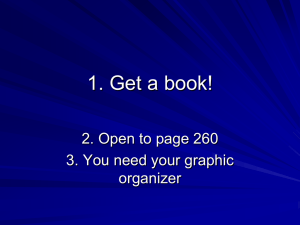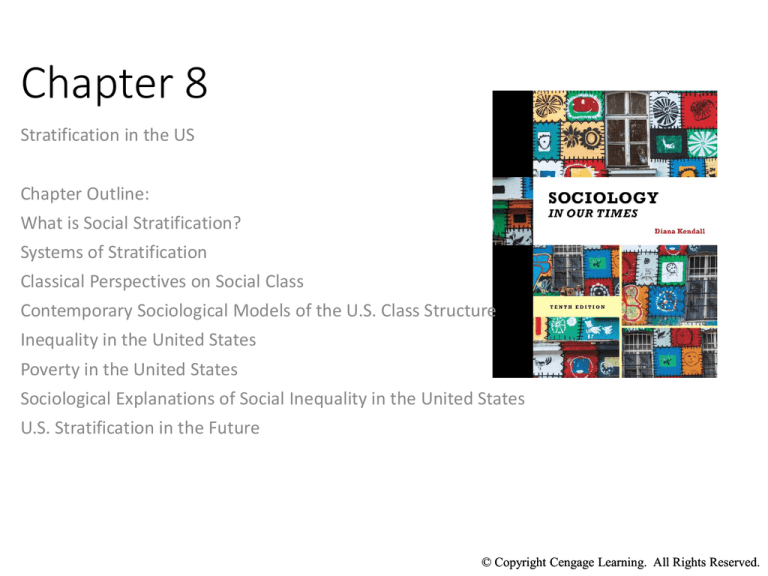
Chapter 8
Stratification in the US
Chapter Outline:
What is Social Stratification?
Systems of Stratification
Classical Perspectives on Social Class
Contemporary Sociological Models of the U.S. Class Structure
Inequality in the United States
Poverty in the United States
Sociological Explanations of Social Inequality in the United States
U.S. Stratification in the Future
© Copyright Cengage Learning. All Rights Reserved.
What is Social Stratification?
• Social stratification is the hierarchical arrangement of
• Life chances refers to the extent to which individuals have access to
Systems of Stratification
• Social mobility is the movement of individuals or groups from one level in
a stratification system to another.
• Intergenerational mobility is the social movement experienced by family
members from one generation to the next.
• Intragenerational mobility is the social movement of individuals within their own
lifetime.
© Copyright Cengage Learning. All Rights Reserved.
• Slavery is an extreme form of stratification in which some people are owned
or controlled by others for the purpose of economic or sexual exploitation.
As practiced in the U.S., slavery had four primary characteristics:
• A caste system is a system of social inequality in which people’s status is
permanently determined at birth based on their parents’ ascribed
characteristics. INDIA is an example
• The class system is a type of stratification based on the ownership and
control of resources and on the type of work that people do.
US is an example
© Copyright Cengage Learning. All Rights Reserved.
Classical Perspectives on Social Class
• Karl Marx
• Class position and the extent of our income and wealth are determined by
our work situation, or our relationship to the means of production.
•
Capitalist class (bourgeoisie) consists of those
•
Working class (proletariat) consists of those
•
The capitalist class exploits the working class
Workers experience alienation—a feeling of powerlessness and estrangement
• Class conflict: the struggle between the capitalist class and the working class
• Marx predicted an end to capitalism when the workers realized they were
oppressed and overthrew the capitalists
© Copyright Cengage Learning. All Rights Reserved.
• Max Weber
• Weber emphasized that no single factor was sufficient for defining the
location of categories of people within the class structure.
• Weber developed a multidimensional approach to social stratification that
reflects the interplay among wealth, prestige, and power.
Weber’s three elements of class:
Wealth: the value of all of a person’s or family’s economic assets, including
income, personal property, and income-producing property
Prestige: the respect or regard with which a person or status position is
regarded by others
Power: the ability of people or groups to achieve their goals despite
opposition from others
• Socioeconomic status (SES) to refer to a combined measure that
attempts to classify individuals, families, or households in terms of
© Copyright Cengage Learning. All Rights Reserved.
Contemporary Sociological Models of the U.S. Class Structure
• The Weberian model of social class is based on (1) education, (2) occupation, and
(3) income.
• The Upper (Capitalist) Class = 1%
• The Upper-Middle Class = 14%
• The Middle Class = 30%
• The Working Class = 30%
• The Working Poor = 20%
• The Underclass = 5%
• The Marxian model identifies ownership of the means of production as the
distinguishing feature of social class.
• The Capitalist Class
• The Managerial Class
• The Small-Business Class
• The Working Class
© Copyright Cengage Learning. All Rights Reserved.
A Contemporary Weberian Model
Upper class (capitalist)
The wealthiest and most powerful class
Often divided into "old money" and "new money"
Upper-middle class
Highly educated professionals
Many families with family-owned businesses
A combination of factors qualifies people for this class: university degree;
authority and independence on the job; high income
Middle class
Two-year or four-year college degrees
Technicians, lower-level managers, and semi-professionals
Working class
Semiskilled
Clerks and salespeople
© Copyright Cengage Learning. All Rights Reserved.
Working poor
Live just above the poverty line
Unskilled jobs, seasonal and migrant jobs, and service jobs
Underclass
Poor and seldom employed
Long-term deprivation
Low levels of education and income
Inequality in the United States
Income is the economic gain
Wealth is the value of all
© Copyright Cengage Learning. All Rights Reserved.
Poverty in the United States
• The official poverty line is based on what the federal government considers to
be the minimum amount of money required for living at a subsistence level.
• Absolute poverty exists when people do not have the means to secure the
most basic necessities of life.
• Relative poverty exists when people may be able to afford basic necessities
but are still unable to maintain an average standard of living.
• Who are the poor?
Age: children are at a much greater risk than older persons
One out of every five children live below the poverty line
Race/ethnicity: White Americans (non-Latinos/as) account for 2/3 of those
below the poverty line
A disproportionate percentage of people of color are poor
Gender: about 2/3 of all adults living in poverty are women
• Consequences of Inequality
• Physical health, mental health, and nutrition; Housing; Education
© Copyright Cengage Learning. All Rights Reserved.
Sociological Explanations of Social Inequality in the United States
• Functionalist Perspectives
• Davis-Moore thesis: inequality is not only inevitable but also necessary for
the smooth functioning of society.
1.
All societies have important tasks that must be accomplished and certain
positions that must be filled.
2.
Some positions are more important for the survival of society than
others.
3.
The most important positions must be filled by the most qualified people.
4.
The positions that are the most important for society must be the most
highly rewarded.
5.
The most highly rewarded positions should be those that are functionally
unique and on which other positions rely.
© Copyright Cengage Learning. All Rights Reserved.
• Conflict Perspectives
• People with economic and political power are able to shape and
distribute the rewards, resources, privileges, and opportunities in society
for their own benefit.
• Symbolic Interactionist Perspectives
• The beliefs and actions of people reflect their class location in society.
© Copyright Cengage Learning. All Rights Reserved.

